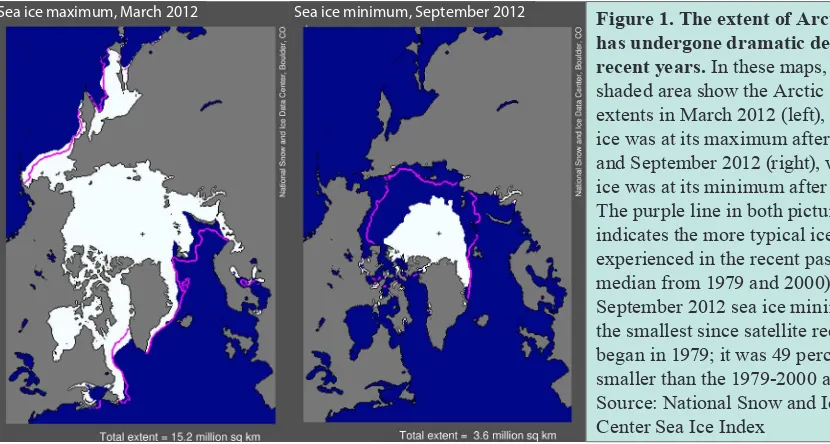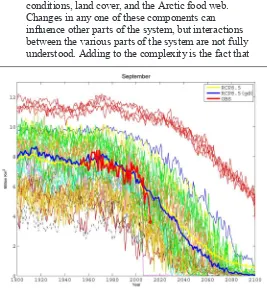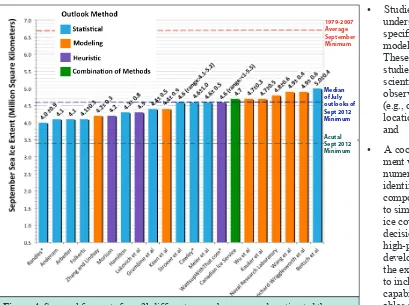S
atellite data show recent dramatic reductions in the extent and thickness of the ice that covers the Arctic sea. During each of the past six summers, sea ice cover has shrunk to cover less area than at any time in the preceding three decades. Winter ice is now thinner, and the compo-sition of the ice that forms is changing, now containing a higher fraction of thin irst-year ice instead of thicker multi-year ice.These changes have brought an array of impacts. The shrinking summer sea ice cover has created larger areas of open ocean, boosting the growth of plankton and causing shifts in the marine food chain. Habitat for the marine mammals who use loating pieces of sea ice as a resting place has diminished. Because the Arctic region moderates the circulation systems of the ocean and atmosphere, changes in the extent of
sea ice could cause shifts in global climate. The Arctic is also a region of increasing economic importance for a diverse range of stakeholders. In addition to impacts on subsistence hunters who depend on over-ice transportation to reach whale and walrus populations, reductions in Arctic sea ice will bring new opportunities and challenges as navigation routes for commercial shippers open up and as access to the region increases for tourism, offshore oil and gas development, and other activities.
Together, these changes have created urgent needs for better predictions of future sea ice conditions. Given the signiicant investments and the progress that has been made in observing and modeling the Arctic sea ice cover, why aren’t we further advanced in the ability to predict its condition on seasonal-to-decadal timescales? To Large reductions in the extent and thickness of Arctic sea ice caused by a warming climate are expected to continue into the coming years, creating widespread environmental and economic changes in the region that have global implications. Although forecasts and models of Arctic sea ice have steadily improved, a limited understanding of the coupled and complex interactions between Arctic sea ice, oceans, and the atmosphere is hampering accurate predictions, even as the demand for them has increased. For example, seasonal outlooks from 21 research groups all underestimated the drop in the extent of summer sea ice that was measured in September 2012. Establishing
sustained communication between the user, modeling, and observation communities could help reveal gaps in understanding, help balance the needs and expectations of different stakeholders, and ensure that resources are allocated to address the most pressing sea ice data needs.
Seasonal-to-Decadal Predictions
of Arctic Sea Ice: Challenges and Strategies
Figure 1. The extent of Arctic sea ice has undergone dramatic declines in recent years. In these maps, the white shaded area show the Arctic sea ice extents in March 2012 (left), when sea ice was at its maximum after winter, and September 2012 (right), when sea ice was at its minimum after summer. The purple line in both pictures indicates the more typical ice extent experienced in the recent past (the median from 1979 and 2000). The September 2012 sea ice minimum was the smallest since satellite records began in 1979; it was 49 percent smaller than the 1979-2000 average. Source: National Snow and Ice Data Center Sea Ice Index
humans have an increasingly large role in the ecosystem, for example by causing oil spills or through greenhouse gas emissions. Treating the Arctic as a vital component of the global system could help scientists better understand its contribu-tion to the climate system and help advance under-standing of sea ice and its predictability.
2. Updating sea ice prediction models to relect changing characteristics of sea ice. Recent reduc-tions in the extent of summer sea ice have also caused shifts in the composition of the ice. Dominated by thick, multi-year ice just a decade ago, thinner irst year now makes up an increasingly large part of the ice cover (see Figure 3). First-year sea ice is more susceptible for summer melt, and is more easily ridged, ruptured, and moved by winds, which has important implications for predicting future sea ice cover. Many current sea ice models use formulations and parameters based on data collected during the multi-year sea ice regime, and may not accurately relect recent changes in sea ice characteristics.
3. Meeting the needs of a wide range of stakehold-ers. Clearly deining the broad and evolving needs of stakeholders would help inform future directions for sea ice modeling and observations in support of sea ice prediction.
Challenges in Advancing Predictive
Capabilities
Although steady progress has been made in understanding Arctic sea ice, many climate models still simulate an Arctic ice pack that is at odds with observations (see Figure 2). Arctic sea ice prediction has some inherent limitations caused by the chaotic nature of the climate system. Those limitations are poorly understood, especially across the full range of timescale and variables of interest to stakeholders. To move toward greater predictability, the following challenges need to be addressed:
1. A better understanding of the relative accuracies, strengths, and weaknesses of the different
approaches used to forecast seasonal ice. Currently, the three approaches for seasonal fore-casts are: (1) statistical models; (2) coupled ice-ocean models; and more recently, (3) coupled atmosphere-ocean-ice models.
2. Knowing the degree of precision required in characterizing initial ice-ocean conditions (e.g., sea ice conditions and upper ocean conditions at the start of the season) in order to generate accurate seasonal predictions. Few experiments have been performed to investigate exactly how to optimize sea ice observations. For example, there’s little information on what observational quality, address this question, the report explores major
chal-lenges in sea ice prediction and identiies methods, observations, and technologies that might advance capabilities to predict the extent of sea ice over seasonal to decadal timescales.
Gaps in Our Understanding
Understanding and projecting future sea ice condi-tions is important to a growing number of stakeholders, including local populations, natural resource industries, ishing communities, commercial shippers, marine tourism operators, national security organizations, regulatory agencies, and the scientiic research commu -nity. The report identiied three overarching challenges that need to be addressed:
1. Understanding the interactions among the various parts of the Arctic system. Sea ice is just one part of the larger Arctic system, which includes components such as ocean currents, atmospheric conditions, land cover, and the Arctic food web. Changes in any one of these components can inluence other parts of the system, but interactions between the various parts of the system are not fully understood. Adding to the complexity is the fact that
Figure 2. Many climate models still simulate an Arctic ice pack that differs from recent observations. This igure shows simulations of September sea ice extent from 1900 to 2100 by 23 global climate models. Each thin colored line represents an average set of runs from one model. The thicker solid red line depicts observed ice extent, which, in recent years, is lower than the average of all the model runs, shown as the thick blue line. This discrepancy, along with the wide spread among model runs, indicate that models have not yet caught up to reality, for
spatial density, location and accuracy are required for different variables. Furthermore, obtaining the data quickly enough to make seasonal predictions can be challenging. Although satellite data on ice extent can be available within a day, near-real-time access remains problematic for other types of data, such as ocean temperatures, salinities, and ice movements collected from sealoor moorings. 3. Improving simulation of realistic climate
forc-ings from the atmosphere and ocean by using coupled climate models, and identifying the model variables and/or processes that contribute to unrealistic simulations. Coupled climate models that are used to generate decadal sea ice predictions generate their own atmospheric and oceanic variables from the basic laws of physics. Any errors in the variables used to drive sea ice, however, can lead to unrealistic sea ice distribu-tions. Simulating realistic atmospheric and oceanic conditions depends on assumptions about future trends in carbon dioxide emissions, aerosol loading, changing surface characteristics, and other factors.
Strategies for the Future
This report identiies steps that could be taken to advance sea ice prediction over seasonal to decadal time scales. Chief among them is to establish sustained and coordinated collaboration among the sea ice data user, modeling, and observation communities. A commitment to establishing better communication could help to more quickly reveal further gaps in understanding of the Arctic environment, and inform effective research activities to generate more accurate, timely, and useful sea ice forecasts. Some stakeholder data requirements may be beyond existing capabilities, and communication with the scientiic community can help manage these expectations. This approach would also help establish a clear set of priorities in line with stakeholder needs, and would guide the allocation of resources to the most promising avenues to meet those needs.
In addition, given the vast amounts of data on Arctic sea ice and the numerous stakeholders who use these data, there is a need for a coordinated and centralized information hub that facilitates timely access to observa-tional and modeling results, unifying the various databases and providing a consistent system for inding and accessing data.
Strategies to Improve Sea Ice Prediction on Seasonal-to-Decadal Time Scales
As shown in Figure 4, seasonal forecasts made in May 2012 by 21 different research groups all underesti-mated the record loss of Arctic sea ice extent in September 2012. Although all the forecasts anticipated ice extents well below historical September averages, the estimates were still too high by more than 1 million square kilometers. While recognizing that there are limitations in current modeling and observational techniques, the report identiies strategies to signii -cantly enhance our understanding and predictions of Arctic sea ice cover over seasonal-to-decadal time scales. The collaboration among the sea ice data user, modeling, and observation communities mentioned above is an essential element in carrying out these strategies, which include:
• An evaluation of the different methods for fore-casting seasonal sea ice to help scientists understand each method’s weaknesses and strengths. Understanding these weaknesses and strengths could help scientists determine which method for forecasting sea ice is best suited for informing different stakeholders;
• A process-based study of seasonal sea ice to understand the impact of the increasing predomi-nance of younger, irst-year ice on sea ice predictions. Process-based studies also offer an opportunity to identify, develop, and test observa-tional instruments;
Figure 3. Sea ice is shifting in composition from
predominantly multi-year ice to thinner irst-year
• Studies to help scientists understand how much speciic variables impact model simulations. These model sensitivity studies could help scientists prioritize observational needs (e.g., observation types, locations, and coverage); and
• A coordinated experi-ment with multiple numerical models to (a) identify which model components are critical to simulating a realistic ice cover and (b) guide decisions regarding high-priority model development needs and the expansion of models to include additional capabilities and vari-ables of interest to stakeholders.
Committee on the Future of Arctic Sea Ice Research in Support of Seasonal-to-Decadal Prediction: Jackie Richter-Menge (Cochair), Cold Regions Research and Engineering Laboratory; John E. Walsh (Cochair), University of Alaska, Fairbanks; Lawson W. Brigham, University of Alaska, Fairbanks; Jennifer A. Francis, Rutgers, The State University of New Jersey; Marika Holland, National Center for Atmospheric Research; Son V. Nghiem, Jet Propulsion Laboratory; Robert Raye, Shell Projects and Technology; Rebecca Woodgate (*resigned) University of Washington; Katie Thomas, Study Director, Lauren Brown, Research Associate, and Elizabeth Finkelman, Senior Program Assitant, National Research Council.
The National Academies appointed the above committee of experts to address the speciic task requested by NASA, the Ofice of Naval Research, and the U.S. intelligence community. The members volunteered their time for this activity; their report is peer-reviewed and the inal product signed off by both the committee members and the National Academies. This report brief was prepared by the National Research Council based on the
committee’s report.
For more information, contact the Polar Research Board at (202) 334-3479 or visit http://dels.nas.edu/prb. Copies of Seasonal-to-Decadal Predictions of Arctic Sea Ice Challenges and Strategies are available from the National Academies Press, 500 Fifth Street, NW, Washington, D.C. 20001; (800) 624-6242; www.nap.edu.
Permission granted to reproduce this brief in its entirety with no additions or alterations.
Permission for images/igures must be obtained from their original source.
© 2012 The National Academy of Sciences
Read or purchase this report and locate information on related reports at
http://dels.nas.edu/prb
Figure 4. Seasonal forecasts from 21 different research groups underestimated the record loss of Arctic sea ice extent that occurred in September 2012. The research groups median outlook was 4.6 million square kilometers, but the actual September 2012 ice extent was 3.61 million square kilometers, which is the lowest September extent on satellite record starting in 1979. Source: Adapted from the Arctic Research Consortium of the U.S. and the Study of Environmental Arctic Change (SEARCH)
Median of July outlooks of Sept 2012 Minimum
Acutal Sept 2012 Minimum



